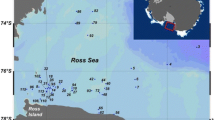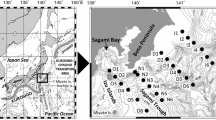Abstract
Spring distributions of some numerically dominant copepods reflect associations with two distinct water masses separated along the 80- to 100-m isobaths. Seaward of this middle shelf front, the oceanic Bering Sea hosts populations of Calanus cristatus, C. plumchrus, and Eucalanus bungii bungii; Metridia pacifica, Oithona similis, and Pseudocalanus spp. are also present. The large oceanic species are much less abundant in waters shallower than 80 m where the community is seasonally dominated by smaller copepods, O. similis, Acartia longiremis, and Pseudocalanus spp. Experimental and field-derived estimates of carbon ingestion indicate that the oceanic/outer shelf copepods can occasionally graze the equivalent of the daily plant production and probably routinely remove 20–30% of the primary productivity. Conversely, stocks of middle shelf copepods rarely ingest more than 5% of the plant carbon productivity. During 45 d between mid April to late May, 1979, approximately three times more organic matter was ingested m-2 by the outer shelf/oceanic copepod community than by middle shelf species. This imbalance in cross-shelf grazing permits middle shelf phytoplankton stocks to grow rapidly to bloom proportions, and to sink ungrazed to the seabed. Over the outer shelf and particularly along the shelf break, a much closer coupling to phytoplankton supports a large biomass of oceanic grazers. Here, copepod stocks approaching 45 g dry wt m-2 occur in late spring as a narrow band at the shelf break.
Similar content being viewed by others
Literature Cited
Bakkala, R., W. Hirschberger and K. King: The groundfish resources of the eastern Bering Sea and Aleutian Islands regions. Mar. Fish. Rev., Nov. 1979, 1–24 (1979)
Coachman, L. K. and R. L. Charnell: Fine structure in outer Bristol Bay, Alaska. Deep-Sea Res. 24, 869–889 (1977)
Coachman, L. K. and R. L. Charnell: On lateral water mass interaction — a case study, Bristol Bay, Alaska. J. Phys. Oceanogr. 9, 278–297 (1979)
Cooney, R. T.: Bering Sea zooplankton and micronekton communities with emphasis on annual production. In: Ed. by D. W. Hood and J. A. Calder. Eastern Bering sea shelf: oceanography and resources, Vol. II pp 947–974. US Dept. of Commerce 1981
Copping, A. E. and C. J. Lorenzen: Carbon budget of a marine phytoplankton — herbivore system with carbon-14 as a tracer. Limnol. Oceanogr. 25, 873–882 (1980)
Ikeda, T. and S. Motoda: Zooplankton production in the Bering Sea calculated from 1956–1970. “Oshoro Maru” data. Mar. Sci. Comm. 4, 329–346 (1978)
Iverson, R. L., L. K. Coachman, R. T. Cooney, T. S. English, J. J. Goering, G. L. Hunt, Jr., M. C. Macauley, C. P. McRoy, W. S. Reeburgh and T. E. Whitledge: Ecological significance of fronts in the southeast Bering Sea, pp 437–466. In: R. J. Livingston [ed.], Ecological processes in coastal and marine systems. New York: Plenum Press 1979a
Iverson, R., T. Whitledge and J. Goering: Chlorophyll and nitrate fine structure in the southeastern Bering Sea shelf break front. Nature, Lond. 281, 664–666 (1979b)
Kinder, T. H. and L. K. Coachman: The front overlaying the continental slope in the eastern Bering Sea. J. Geophys. Res. 83, 4551–4559 (1978)
Lovegrove, T.: The determination of the dry weight of plankton and the effect of various factors on values obtained, pp 429–467. In: H. Barnes [ed.], Some contemporary studies in marine science. New York: Hafner 1966
Lubney-Gerzyk, Y. A.: Weight characteristics based on representative zooplankton from the Okhotsk and Bering Seas (in Russian). Dokl. Akad. Nauk SSSR 91(4), 949–952 (1953)
Minoda, T.: Pelagic copepods in the Bering Sea and the northwestern North Pacific with special reference to their vertical distribution. Mem. Fac. Fish Hokkaido Univ. 18, 1–74 (1971)
Motoda, S. and T. Minoda: Plankton of the Bering Sea, pp 207–241. In: D. W. Hood and E. J. Kelley [eds.], Oceanography of the Bering Sea with emphasis on renewable resources. Fairbanks: Univ. Alaska 1974
Mullin, M. M., P. R. Sloan and R. W. Eppley: Relationship between carbon content, cell volume, and area in phytoplankton. Limnol. Oceanogr. 11, 307–311 (1966)
Paffenhöfer, G. A. and R. P. Harris: Feeding, growth, and reproduction of the marine planktonic copepod Pseudocalanus elongatus Boeck. J. mar. biol. Assoc. U.K. 56, 327–344 (1976)
Paffenhöfer, G. A.: Zooplankton distribution as related to summer hydrographic conditions on Onslow Bay, North Carolina. Bull. mar. Sci. 30, 819–832 (1980)
Vinogradov, M. E. and E. G. Arashkevich: Vertical distribution of interzonal copepod filter feeders and their role in communities at different depths in the northwestern Pacific. Oceanology 9, 399–409 (1969)
Walsh, J. J., T. E. Whitledge, F. W. Barnevik, C. D. Wirick, S. O. Howe, W. E. Esaias and J. T. Scott: Wind events and food chain dynamics in the New York Bight. Limnol. Oceanogr. 23, 659–683 (1978)
Walsh, J. J., G. T. Rowe, R. L. Iverson and C. P. McRoy: Biological export of shelf carbon is a sink of the global CO2 cycle. Nature, Lond. 291, 196–201 (1981)
Author information
Authors and Affiliations
Additional information
Communicated by R. O. Fournier, Halifax
Supported by National Science Foundation Grant DPP 76-23340
Contribution no. 485, Institute of Marine Science, University of Alaska, Fairbanks
Rights and permissions
About this article
Cite this article
Cooney, R.T., Coyle, K.O. Trophic implications of cross-shelf copepod distributions in the Southeastern Bering Sea. Mar. Biol. 70, 187–196 (1982). https://doi.org/10.1007/BF00397684
Accepted:
Issue Date:
DOI: https://doi.org/10.1007/BF00397684




